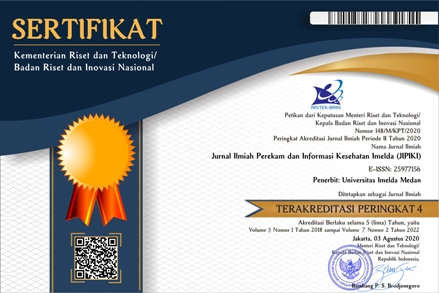Asesmen Kode Penyebab Kematian di RSUD Panembehan Senopati Bantul Yogykarta
DOI:
https://doi.org/10.52943/jipiki.v7i2.1028Keywords:
rekam medis, ICD-10, kelengkapan, kode, kematianAbstract
a complete medical record reflects the quality of good documentation, the complete of diagnosis writing reduces incorrect and inaccurate code and appropriate reporting to support decision makers. this study aims to measure the completeness and accuracy of the death code and the basic cause of death of patients. This study uses a quantitative descriptive design using a completeness checklist instrument. researchers used secondary data from the medical records of patients who died in 2021, the total sample was 199 using the slovin formula. secondary data analyzed with STATA, presented with tabulations and descriptive narratives. the basic cause of the basic cause of death was highest in code J80 at 33 (17%), J12.8 at 21 (11%) and the third being E11.9 . Based on the category of completeness of filling out of the 199 medical records analyzed, there were 37% (75) death forms that were not filled in completely
Downloads
References
[2] U. Zellweger, C. Junker, and M. Bopp, “Cause of death coding in Switzerland?: evaluation based on a nationwide individual linkage of mortality and hospital in-patient records,” vol. 2, pp. 1–15, 2019.
[3] World Health Organization, “Medical certification, ICD mortality coding, and reporting mortality associated with COVID-19,” Tech. Note, vol. 19, no. June, pp. 1–13, 2020, [Online]. Available: https://www.who.int/publications/i/item/WHO-2019-nCoV-mortality-reporting-2020-1.
[4] R. H. Hazard et al., “The quality of medical death certification of cause of death in hospitals in rural Bangladesh: Impact of introducing the International Form of Medical Certificate of Cause of Death,” BMC Health Serv. Res., vol. 17, no. 1, pp. 1–8, 2017, doi: 10.1186/s12913-017-2628-y.
[5] L. Falci, E. J. L. Argov, G. Van Wye, M. Plitt, A. Soto, and M. Huynh, “Practice of Epidemiology Examination of Cause-of-Death Data Quality Among New York City Deaths Due to Cancer , Pneumonia , or Diabetes From 2010 to 2014,” vol. 187, no. 1, pp. 144–152, 2018, doi: 10.1093/aje/kwx207.
[6] C. Opitasari and A. Nurwahyuni, “The completeness and accuracy of clinical coding for diagnosis and medical procedure on the INA-CBGs claim amounts at a hospital in South Jakarta,” vol. 9, no. 1, pp. 14–18, 2018, doi: 10.22435/hsji.v9i1.464.
[7] A. H. Krist et al., “Electronic health record functionality needed to better support primary care,” J. Am. Med. Informatics Assoc., 2014, doi: 10.1136/amiajnl-2013-002229.
[8] U. E. Paulista, P. D. E. P. Em, and C. Biológicas, “The 2nd International Conference on Health Sciences,” in The 2nd International Conference on Health Sciences, 2017, pp. 1–186.
[9] World Health Organization (WHO), “COVID-19 Weekly Epidemiological Update,” 2022.
[10] S. A. Lauer et al., “The Incubation Period of Coronavirus Disease 2019 (COVID-19) From Publicly Reported Confirmed Cases: Estimation and Application,” Ann. Intern. Med., vol. 2019, 2020, doi: 10.7326/m20-0504.
[11] Y. Wu, C. Chen, and Y. Chan, “The outbreak of COVID-19?: An overview,” J. Chinese Med. Assoc., vol. 83, pp. 217–220, 2020, doi: 10.1097/JCMA.0000000000000270>Wu.
[12] S. Yokohama, “Morbidity and Mortality Weekly Report ( MMWR ) Initial Investigation of Transmission of COVID-19 Among Crew Members During Quarantine of a Cruise,” vol. 69, no. February, 2020.
[13] R. M. Burke et al., “Active Monitoring of Persons Exposed to Patients with Confirmed COVID-19 - United States, January-February 2020,” MMWR. Morb. Mortal. Wkly. Rep., vol. 69, no. 9, pp. 245–246, 2020, doi: 10.15585/mmwr.mm6909e1.
[14] WHO, “International Guidelines For Certification and Classification (Coding) of Covid-19 as Cause of Death Based on ICD International Statistical Classification of Diseases Table of Contents,” no. April, 2020.
[15] B. Singh, “International comparisons of COVID-19 deaths in the presence of comorbidities require uniform mortality coding guidelines,” Int. J. Epidemiol., vol. 50, no. 2, pp. 373–377, 2021, doi: 10.1093/ije/dyaa276.
[16] H. Asari, L. R. Ilmi, and N. Intan, “Kelengkapan dan Keakuratan Pemberian Kode Diagnosis Kasus Neoplasma,” Pros. Semin. Rekam Medis dan Inf. Kesehat. “Inovasi Teknol. Inf. Untuk Mendukung Kerja PMIK Dalam Rangka Kendali Biaya di Fasilitas Pelayanan Kesehatan,” vol. 80, pp. 39–43, 2020, [Online]. Available: https://publikasi.aptirmik.or.id/index.php/procinovasiTI/article/view/75.
[17] L. R. Ilmi and Z. Purbobinuko, “Penentu Penyebab Kematian Di Rsud Panembahan Senopati Bantul?: Miscoding Berdampak Pada Laporan Statistik Kematian,” J. Manaj. Inf. Kesehat. Indones., vol. 8, no. 1, p. 86, 2020, doi: 10.33560/jmiki.v8i1.253.
[18] L. R. Ilmi, “Cause of Death Reported and Administrative Code with Sepsis and Trend in Panembahan Senopati General Hospital,” Proceeding- 2nd ISMOHIM, vol. 5, no. 1, pp. 82–86, 2020.
[19] X. Jin et al., “Epidemiological, clinical and virological characteristics of 74 cases of coronavirus-infected disease 2019 (COVID-19) with gastrointestinal symptoms,” Gut, pp. 1–8, 2020, doi: 10.1136/gutjnl-2020-320926.
[20] J. Miki, R. Rampatige, N. Richards, T. Adair, J. Cortez-Escalante, and J. Vargas-Herrera, “Saving lives through certifying deaths: Assessing the impact of two interventions to improve cause of death data in Perú,” BMC Public Health, vol. 18, no. 1, pp. 1–11, 2018, doi: 10.1186/s12889-018-6264-1.
[21] N. S. Elbarbary, T. J. dos Santos, C. de Beaufort, E. Wiltshire, A. Pulungan, and A. E. Scaramuzza, “The Challenges of Managing Pediatric Diabetes and Other Endocrine Disorders During the COVID-19 Pandemic: Results From an International Cross-Sectional Electronic Survey,” Front. Endocrinol. (Lausanne)., vol. 12, no. November, pp. 1–19, 2021, doi: 10.3389/fendo.2021.735554.
[22] P. K. Lindenauer, T. Lagu, M. S. Shieh, P. S. Pekow, and M. B. Rothberg, “Association of Diagnostic Coding with trends in hospitalizations and mortality of patients with pneumonia, 2003-2009,” JAMA - J. Am. Med. Assoc., vol. 307, no. 13, pp. 1405–1413, 2012, doi: 10.1001/jama.2012.384.
[23] P. K. Lindenauer, T. Lagu, M. S. Shieh, P. S. Pekow, and M. B. Rothberg, “Association of Diagnostic Coding with trends in hospitalizations and mortality of patients with pneumonia, 2003-2009,” JAMA - J. Am. Med. Assoc., vol. 307, no. 13, pp. 1405–1413, 2012, doi: 10.1001/jama.2012.384.
[24] H. C. Prescott, J. J. Osterholzer, K. M. Langa, D. C. Angus, and T. J. Iwashyna, “Late mortality after sepsis: Propensity matched cohort study,” BMJ, vol. 353, pp. 1–8, 2016, doi: 10.1136/bmj.i2375.
[25] Y. Miyasaka et al., “Mortality Trends in Patients Diagnosed With First Atrial Fibrillation. A 21-Year Community-Based Study,” J. Am. Coll. Cardiol., vol. 49, no. 9, pp. 986–992, 2007, doi: 10.1016/j.jacc.2006.10.062.
[26] A. J. Walker et al., “ Clinical coding of long COVID in English primary care: a federated analysis of 58 million patient records in situ using OpenSAFELY ,” Br. J. Gen. Pract., vol. 71, no. 712, pp. e806–e814, 2021, doi: 10.3399/bjgp.2021.0301.
[27] J. Austin, M. Barras, and C. Sullivan, “Interventions designed to improve the safety and quality of therapeutic anticoagulation in an inpatient electronic medical record,” International Journal of Medical Informatics, vol. 135. 2020, doi: 10.1016/j.ijmedinf.2019.104066.
[28] R. J. Jolley et al., “Validation and optimisation of an ICD-10-coded case definition for sepsis using administrative health data,” BMJ Open, vol. 5, no. 12, pp. 1–10, 2015, doi: 10.1136/bmjopen-2015-009487.
[29] E. K. Nichols et al., “The WHO 2016 verbal autopsy instrument?: An international standard suitable for automated analysis by InterVA , InSilicoVA , and Tariff 2 . 0,” pp. 1–9, 2018.
[30] G. Filippatos et al., “The quality of death certification practice in Greece,” Hippokratia, vol. 20, no. 1, pp. 19–25, 2016.
[31] G. Husabø et al., “Early diagnosis of sepsis in emergency departments, time to treatment, and association with mortality: An observational study,” PLoS One, vol. 15, no. 1, pp. 1–15, 2020, doi: 10.1371/journal.pone.0227652.
[32] B. S. T. J. M. S. Reza Jafarazdeh, “Quantifying the improvement in sepsis diagnosis, documentation and coding: the marginal causal effect of year of hospitalization on sepsis diagnosis,” Physiol. Behav., vol. 176, no. 5, pp. 139–148, 2017, doi: 10.1016/j.physbeh.2017.03.040.
[33] C. Noteboom, J. Hafner, and A. Wahbeh, “Characteristics of Complete and Incomplete Physicians’ Unlearning with Electronic Medical Record,” J. Midwest Assoc. Inf. Syst., vol. 2017, no. 2, pp. 57–72, 2017, doi: 10.17705/3jmwa.00031.











